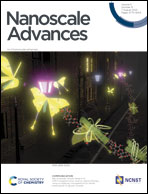Tuning the charge carrier polarity of roll-to-roll gravure printed carbon nanotube-based thin film transistors by an atomic layer deposited alumina nanolayer†
Abstract
Charge carrier polarity tuning in printed thin film transistors (TFTs) is a crucial step in order to obtain complementary printed devices. In this work, we studied the effect of an Al2O3 passivation layer on printed single-walled carbon nanotube (SWCNT) based TFTs to tune the charge carrier polarity. By varying the atomic layer deposition (ALD) temperature and Al2O3 layer thickness, we can tune the doping degree of Al2O3 to tailor the polarity of printed SWCNT-based TFTs (SWCNT-TFTs). The precise control of threshold voltage (Vth) and polarity from p-type to well-balanced ambipolar, and n-type SWCNT-TFTs is successfully demonstrated with high repeatability by optimizing the ALD temperature and Al2O3 layer thickness based on 20 printed samples per test. As a proof-of-concept, inverter logic circuits using the SWCNT-TFT with different polarity types are demonstrated. The ambipolar device-based inverter exhibits a voltage gain of 3.9 and the CMOS-based inverter exhibits a gain of approximately 4.3, which is comparable to the current roll-to-roll (R2R) printed inverter circuits. Different thicknesses of Al2O3 layer, coated by the ALD at different temperatures and thicknesses, provide a deep understanding of the device fabrication and control process to implement the tailored doping method to efficiently realize R2R printed SWCNT-TFT-based complementary electronic devices.

- This article is part of the themed collections: Popular Advances and 2024 Lunar New Year Collection


 Please wait while we load your content...
Please wait while we load your content...